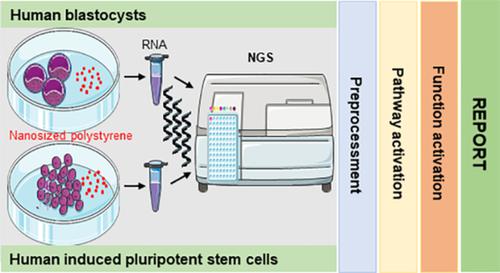当前位置:
X-MOL 学术
›
STEM CELLS
›
论文详情
Our official English website, www.x-mol.net, welcomes your feedback! (Note: you will need to create a separate account there.)
Platform to study intracellular polystyrene nanoplastic pollution and clinical outcomes
STEM CELLS ( IF 5.2 ) Pub Date : 2020-07-02 , DOI: 10.1002/stem.3244 Sanja Bojic 1, 2 , Matias M Falco 3, 4 , Petra Stojkovic 5 , Biljana Ljujic 2 , Marina Gazdic Jankovic 2 , Lyle Armstrong 1 , Nebojsa Markovic 5 , Joaquin Dopazo 3, 4, 6 , Majlinda Lako 1 , Roman Bauer 1 , Miodrag Stojkovic 2, 5
STEM CELLS ( IF 5.2 ) Pub Date : 2020-07-02 , DOI: 10.1002/stem.3244 Sanja Bojic 1, 2 , Matias M Falco 3, 4 , Petra Stojkovic 5 , Biljana Ljujic 2 , Marina Gazdic Jankovic 2 , Lyle Armstrong 1 , Nebojsa Markovic 5 , Joaquin Dopazo 3, 4, 6 , Majlinda Lako 1 , Roman Bauer 1 , Miodrag Stojkovic 2, 5
Affiliation

|
Increased pollution by plastics has become a serious global environmental problem, but the concerns for human health have been raised after reported presence of microplastics (MPs) and nanoplastics (NPs) in food and beverages. Unfortunately, few studies have investigate the potentially harmful effects of MPs/NPs on early human development and human health. Therefore, we used a new platform to study possible effects of polystyrene NPs (PSNPs) on the transcription profile of preimplantation human embryos and human induced pluripotent stem cells (hiPSCs). Two pluripotency genes, LEFTY1 and LEFTY2, which encode secreted ligands of the transforming growth factor‐beta, were downregulated, while CA4 and OCLM, which are related to eye development, were upregulated in both samples. The gene set enrichment analysis showed that the development of atrioventricular heart valves and the dysfunction of cellular components, including extracellular matrix, were significantly affected after exposure of hiPSCs to PSNPs. Finally, using the HiPathia method, which uncovers disease mechanisms and predicts clinical outcomes, we determined the APOC3 circuit, which is responsible for increased risk for ischemic cardiovascular disease. These results clearly demonstrate that better understanding of NPs bioactivities and its implications for human health is of extreme importance. Thus, the presented platform opens further aspects to study interactions between different environmental and intracellular pollutions with the aim to decipher the mechanism and origin of human diseases.
中文翻译:

研究细胞内聚苯乙烯纳米塑料污染和临床结果的平台
塑料造成的污染加剧已成为一个严重的全球环境问题,但在食品和饮料中存在微塑料 (MPs) 和纳米塑料 (NPs) 的报道后,人们对人类健康的担忧有所增加。不幸的是,很少有研究调查 MPs/NPs 对人类早期发育和人类健康的潜在有害影响。因此,我们使用一个新平台来研究聚苯乙烯 NPs (PSNPs) 对植入前人类胚胎和人类诱导多能干细胞 (hiPSCs) 转录谱的可能影响。两个多能性基因 LEFTY1 和 LEFTY2 编码转化生长因子-β 的分泌配体,被下调,而与眼睛发育相关的 CA4 和 OCLM 在两个样本中都被上调。基因集富集分析表明,hiPSCs 暴露于 PSNPs 后,房室心脏瓣膜的发育和细胞成分(包括细胞外基质)的功能障碍受到显着影响。最后,使用揭示疾病机制并预测临床结果的 HiPathia 方法,我们确定了导致缺血性心血管疾病风险增加的 APOC3 回路。这些结果清楚地表明,更好地了解 NPs 生物活性及其对人类健康的影响非常重要。因此,所提出的平台为研究不同环境和细胞内污染之间的相互作用开辟了更多方面,旨在破译人类疾病的机制和起源。hiPSCs 暴露于 PSNPs 后,包括细胞外基质在内的细胞外基质受到显着影响。最后,使用揭示疾病机制并预测临床结果的 HiPathia 方法,我们确定了导致缺血性心血管疾病风险增加的 APOC3 回路。这些结果清楚地表明,更好地了解 NPs 生物活性及其对人类健康的影响非常重要。因此,所提出的平台为研究不同环境和细胞内污染之间的相互作用开辟了更多方面,旨在破译人类疾病的机制和起源。hiPSCs 暴露于 PSNPs 后,包括细胞外基质在内的细胞外基质受到显着影响。最后,使用揭示疾病机制并预测临床结果的 HiPathia 方法,我们确定了导致缺血性心血管疾病风险增加的 APOC3 回路。这些结果清楚地表明,更好地了解 NPs 生物活性及其对人类健康的影响非常重要。因此,所提出的平台为研究不同环境和细胞内污染之间的相互作用开辟了更多方面,旨在破译人类疾病的机制和起源。我们确定了导致缺血性心血管疾病风险增加的 APOC3 回路。这些结果清楚地表明,更好地了解 NPs 生物活性及其对人类健康的影响非常重要。因此,所提出的平台为研究不同环境和细胞内污染之间的相互作用开辟了更多方面,旨在破译人类疾病的机制和起源。我们确定了导致缺血性心血管疾病风险增加的 APOC3 回路。这些结果清楚地表明,更好地了解 NPs 生物活性及其对人类健康的影响非常重要。因此,所提出的平台为研究不同环境和细胞内污染之间的相互作用开辟了更多方面,旨在破译人类疾病的机制和起源。
更新日期:2020-07-02
中文翻译:

研究细胞内聚苯乙烯纳米塑料污染和临床结果的平台
塑料造成的污染加剧已成为一个严重的全球环境问题,但在食品和饮料中存在微塑料 (MPs) 和纳米塑料 (NPs) 的报道后,人们对人类健康的担忧有所增加。不幸的是,很少有研究调查 MPs/NPs 对人类早期发育和人类健康的潜在有害影响。因此,我们使用一个新平台来研究聚苯乙烯 NPs (PSNPs) 对植入前人类胚胎和人类诱导多能干细胞 (hiPSCs) 转录谱的可能影响。两个多能性基因 LEFTY1 和 LEFTY2 编码转化生长因子-β 的分泌配体,被下调,而与眼睛发育相关的 CA4 和 OCLM 在两个样本中都被上调。基因集富集分析表明,hiPSCs 暴露于 PSNPs 后,房室心脏瓣膜的发育和细胞成分(包括细胞外基质)的功能障碍受到显着影响。最后,使用揭示疾病机制并预测临床结果的 HiPathia 方法,我们确定了导致缺血性心血管疾病风险增加的 APOC3 回路。这些结果清楚地表明,更好地了解 NPs 生物活性及其对人类健康的影响非常重要。因此,所提出的平台为研究不同环境和细胞内污染之间的相互作用开辟了更多方面,旨在破译人类疾病的机制和起源。hiPSCs 暴露于 PSNPs 后,包括细胞外基质在内的细胞外基质受到显着影响。最后,使用揭示疾病机制并预测临床结果的 HiPathia 方法,我们确定了导致缺血性心血管疾病风险增加的 APOC3 回路。这些结果清楚地表明,更好地了解 NPs 生物活性及其对人类健康的影响非常重要。因此,所提出的平台为研究不同环境和细胞内污染之间的相互作用开辟了更多方面,旨在破译人类疾病的机制和起源。hiPSCs 暴露于 PSNPs 后,包括细胞外基质在内的细胞外基质受到显着影响。最后,使用揭示疾病机制并预测临床结果的 HiPathia 方法,我们确定了导致缺血性心血管疾病风险增加的 APOC3 回路。这些结果清楚地表明,更好地了解 NPs 生物活性及其对人类健康的影响非常重要。因此,所提出的平台为研究不同环境和细胞内污染之间的相互作用开辟了更多方面,旨在破译人类疾病的机制和起源。我们确定了导致缺血性心血管疾病风险增加的 APOC3 回路。这些结果清楚地表明,更好地了解 NPs 生物活性及其对人类健康的影响非常重要。因此,所提出的平台为研究不同环境和细胞内污染之间的相互作用开辟了更多方面,旨在破译人类疾病的机制和起源。我们确定了导致缺血性心血管疾病风险增加的 APOC3 回路。这些结果清楚地表明,更好地了解 NPs 生物活性及其对人类健康的影响非常重要。因此,所提出的平台为研究不同环境和细胞内污染之间的相互作用开辟了更多方面,旨在破译人类疾病的机制和起源。



























 京公网安备 11010802027423号
京公网安备 11010802027423号